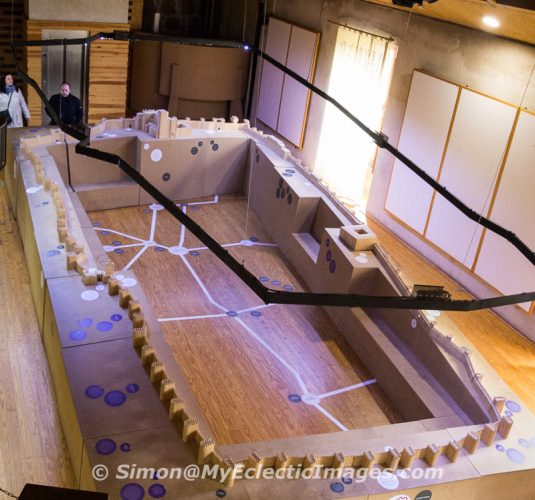Small in Size, But Huge When It comes to Accessibility Awareness.
It was easy for me to figure out our location, as my feet navigated stone steps and walkways atop the wall surrounding the medieval town of Avila. This was because, earlier that day, Simon, Otto and I had paid a visit to the Visitor Reception Center, and encountered a totally unexpected WOW.
Present for the edification of individuals, with or without sight, were scale models of five of the nine gates of the city wall, as well as a detailed model of the exterior of Avila’s cathedral, accompanied by information in print and in Braille. Since we intended to visit both sites, I spent a generous amount of time letting my fingers do the walking before my feet ever touched stone.

Scale Model of One of the City Gates through the City Wall in Avila Spain (©simon@myeclecticimages.com)

Plan of the City Wall with the Position of the Gate Represented by the Model Indicated with a Raised Brass Pin (©simon@myecelcticimages.com
Thinking this was a giant step forward in the area of inclusiveness, we proceeded to the wall. But there, another surprise awaited us. At the main entrance, a scale model of the entire wall, around which we could walk, and identify each gate stopped us in our tracks. The model showed where the cathedral had been built into the wall, all the rises and falls along the top of the wall, where stairs were located and what lay below the wall at street level.
However, accessibility is not only reserved for people who are blind. Materials are available in many languages, type sizes, and in Braille. The section of the wall known as the Gate of El Puente. opened in 2008, enabling visitors in wheelchairs or with compromised mobility to access part of the wall by way of ramps. The area also has a multimedia information display, which includes a figure interpreting the spoken text in sign language. A similar display can also be found in the Visitor Reception Center, along with a 3-D painting of Santa Teresa.

Multimedia Display on the Wheelchair Ramp Providing Accessibility to Part of the City Wall (©simon@myeclecticimages.com)
An accessible route to Avila’s main monuments, beginning at the Visitor Reception Centre, passing the Basilica of San Vicente, cutting through the park with the same name and to the House of Las Carnicerías. The route continues through the Gate of Los Leales or El Peso de la Harina, to Plaza de la Catedral, the site of the most significant church in Ávila. Meandering through pedestrian walkways, commercial areas, past historical and architectural points of interest, all the way to Plaza de Santa Teresa, located outside the wall. The route continues as far as the Convent of Santa Teresa. .
The official website for Avila is packed with information about Avila, its history, important sites, places to stay and to eat, as well as downloadable documents on which sites, hotels and restaurants are accessible to people with mobility impairments. Considering the walled portion of the city dates back to the 11th century, the ongoing effort to make this town of just over 53,000 inhabitants accessible to as many locals and visitors as possible is truly admirable.
Ávila was designated a UNESCO World Heritage Site in 1985, and has won awards for its commitment to accessibility.
Among the many monuments accessible to all is the cathedral. By the time we paid it a visit, the 3-D floor plan available for hands-on inspection came as no surprise.
Naturally, there is much more to see and do in Avila. The WOWs are too numerous to mention here, but they all began with the first WOW that greeted me at the Visitor Reception Center.
Avila is a town with much to offer in the way of history, architecture and cuisine. Learn more about this medieval jewel from the city’s official website.









Hi Penny! Doug and I visited Avila in March. While there, looking at the fabulous hands-on displays, we both thought of you and how much you would appreciate and enjoy a visit there. The painting of Santa Theresa was especially eye catching with its sign which said “forbidden not to touch.” Who could resist feeling it just to discover what “feeling” a painting is like! Wouldn’t it be wonderful if all the castles’ visitors centers had small scale displays around which one could travel by hand.
Avila is a magical place, as I’m sure you know. Our travels in Spain have taught us that there is what appears to be a national commitment to accessibility in most parts of the country. That is one of many reasons why a piece of my heart will always be in Spain.